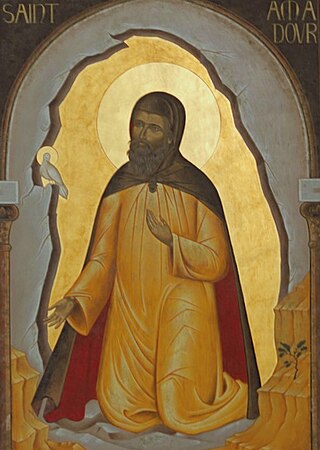
Germanus of Auxerre was a western Roman clergyman who was bishop of Autissiodorum in Late Antique Gaul. He abandoned a career as a high-ranking government official to devote his formidable energy towards the promotion of the church and the protection of his "flock" in dangerous times, personally confronting, for instance, the barbarian king "Goar". In Britain he is best remembered for his journey to combat Pelagianism in or around 429 AD, and the records of this visit provide valuable information on the state of post-Roman British society. He also played an important part in the establishment and promotion of the Cult of Saint Alban. The saint was said to have revealed the story of his martyrdom to Germanus in a dream or holy vision, and Germanus ordered this to be written down for public display. Germanus is venerated as a saint in both the Roman Catholic and Orthodox churches, which commemorate him on 31 July.

Germain was the bishop of Paris and is venerated as a saint in both the Catholic Church and the Eastern Orthodox Church. According to an early biography, he was known as Germain d'Autun, rendered in modern times as the "Father of the Poor".

Illtud, also known as Illtud Farchog or Illtud the Knight, is venerated as the abbot teacher of the divinity school, Bangor Illtyd, located in Llanilltud Fawr in Glamorgan, Wales. He founded the monastery and college in the 6th century, and the school is believed to be Britain's earliest centre of learning. At its height, it had over a thousand pupils and schooled many of the great saints of the age, such as David, Samson of Dol, and the historian Gildas.

Rocamadour is a commune in the Lot department in southwestern France. It lies in the former province of Quercy. It is a member of Les Plus Beaux Villages de France Association.

March 26 – Eastern Orthodox liturgical calendar – March 28

May 15 - Eastern Orthodox Church calendar - May 17

Saint Corbinian was a Frankish bishop. After living as a hermit near Chartres for fourteen years, he made a pilgrimage to Rome. Pope Gregory II sent him to Bavaria. His opposition to the marriage of Duke Grimoald to his brother's widow, Biltrudis, caused Corbinian to go into exile for a time. His feast day is 8 September. The commemoration of the translation of his relics is 20 November.

Saint Alban is venerated as the first-recorded British Christian martyr, for which reason he is considered to be the British protomartyr. Along with fellow Saints Julius and Aaron, Alban is one of three named martyrs recorded at an early date from Roman Britain. He is traditionally believed to have been beheaded in Verulamium sometime during the 3rd or 4th century, and has been celebrated there since ancient times.

Saint Randoald was prior of the Benedictine Moutier-Grandval Abbey under Germanus of Granfelden. He is recognised as a saint in the Catholic and Eastern Orthodox Churches.

Saint Amadour is the legendary founder of the shrine of Our Lady of Rocamadour in France. He is believed to have been a hermit. His feast day is 20 August. There is also a legendary pilgrimage path closeby to his shrine.

Saint Julian of Le Mans is a saint venerated in both the Roman Catholic and Orthodox Church, honoured as the first bishop of Le Mans. His feast day is 27 January. The translation of his relics is celebrated on 25 July.

The diocese of Auxerre is a former French Roman Catholic diocese. Its historical episcopal see was in the city of Auxerre in Burgundy, now part of eastern France. Currently the non-metropolitan Archbishop of Sens, ordinary of the diocese of Sens and Auxerre, resides in Auxerre.
Saint Aunarius (Aunacharius) (French: Aunaire, Aunachaire, Anachaire) (c.540–c.603) was bishop of Auxerre during the 6th century.

The Abbey of Saint-Germain d'Auxerre is a former Benedictine monastery in central France, dedicated to its founder Saint Germain of Auxerre, the bishop of Auxerre, who died in 448. It was founded on the site of an oratory built by Germanus in honor of Saint Maurice.
Aaron of Auxerre was a bishop of Auxerre. His relics are venerated in the Church of Saint-Germain in Auxerre, where his feast day is celebrated on 28 September.

Saint Germanus of Granfelden was the first abbot of Moutier-Grandval Abbey. He is venerated as a martyr saint in the Catholic and Eastern Orthodox Churches.
Amador of Portugal or of Guarda was a hermit from Portugal. He was venerated as a saint by the Catholic Church and his feast day is celebrated on 27 March.
Helladius of Auxerre was the bishop of Auxerre for thirty years from 357 until his death. St. Amator was converted to Christianity, ordained a deacon and tonsured by Helladius, which provides the earliest example of ecclesiastical tonsure mentioned in the religious history of France.

Lupus was an early bishop of Troyes. Around 426, the bishops in Britain requested assistance from the bishops of Gaul in dealing with Pelagianism. Germanus of Auxerre and Lupus were sent.

The Vita Germani is a hagiographic text written by Constantius of Lyon in the 5th century AD. It is one of the first hagiographic texts written in Western Europe, and is an important resource for historians studying the origins of saintly veneration and the "cult of saints." It recounts the life and acts of bishop Germanus of Auxerre, who travelled to Britain c. 429 AD, and is the principal source of details about his life. It is one of the few surviving texts from the 5th century with information about Britain and the Pelagian controversy, and is also one of the first texts to identify and promote the cult of Saint Alban.















